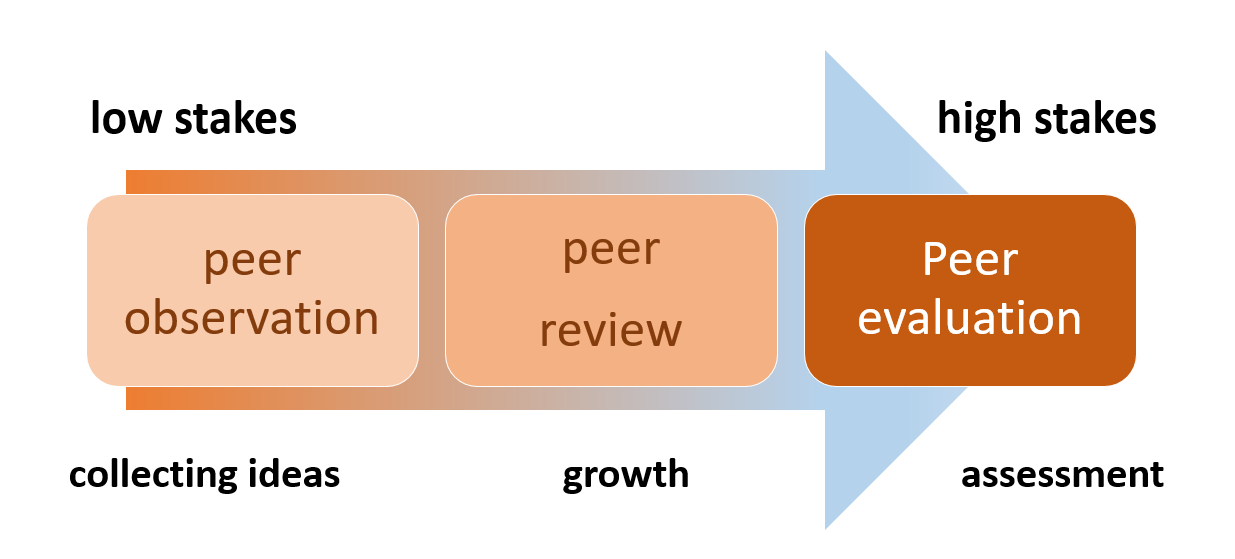Fall 2020 Update: Peer Review of Online Teaching
Good teaching is based on effective principles, no matter which mode of operation. The Center for Teaching and Learning has compiled Eight Principles for Effective Teaching to assist departments in deciding how to evaluate teaching in their discipline. The following section of this webpage, which is based upon the Peer Review of Teaching White Paper written by a large committee of senior UT faculty in 2014 (written under the assumption that classes were mainly in person), is dedicated to updates about Peer Review for online courses.
In general, Peer Review of teaching can serve two purposes: (1) professional growth and (2) data for tenure and promotion. It is recommended that instructors organize a Peer Review the semester before their Peer Evaluation so that instructors can collect ideas about and grow in their teaching.

Specific to Peer Review of online teaching, online classes usually consist of asynchronous (students working on their own time) and synchronous (specific time when faculty and students meet together) components. Both are equally important and, therefore, have to be considered when observing or evaluating a class in order to give an accurate depiction of the pedagogy of the class.
Below is a suggested procedure for Peer Review of online classes that is based upon the four-stage framework outlined in the Peer Review of Teaching White Paper.

Pre-observation
Pre-observation is a two-part process consisting of: 1) closely examining the asynchronous course materials an instructor has organized to support student learning, and 2) engaging in purposeful conversation with the instructor about synchronous class expectations and context; these will provide necessary background for the synchronous observation.
Observation
This section will happen if some of the course is taught synchronously. The observer will join the online session for a focused and purposeful inquiry into observable teaching and learning.
Post-observation
The post-observation is a follow-up meeting of the observer and instructor to bring data, questions, and suggestions from the materials' review and the observation (if relevant) together in a mutual conversation about effective teaching and learning and building an action plan for growth.
Reflective summary
A reflective summary is a brief, written analysis by the instructor and possibly the peer observer of what was learned about teaching and student learning. It is an opportunity to reflect on what to start, what to stop, and what to continue.
It is the responsibility of departments to establish criteria for Peer Evaluations, so contact chairs for department-specific policies. Below is a list of questions that can stimulate thoughts and ideas for developing criteria:
Peer Review of In-Person Teaching
Good teachers continually learn and develop. Peer Review, which combines the examination of course materials with in-class observations and collegial discussion, helps prompt this learning among faculty. Ideally, these interactions and conversations can create opportunities for us as colleagues to reflect on and adapt our teaching practices in order to become better teachers and increase student learning.
This information aims to assist each department in developing a customized system of Peer Review appropriate to its particular discipline. We envision the following steps in developing this customized system:
Step 1: Framing Departmental Discussions: The academic department addresses key questions and decisions about core purposes, terms, and practices associated with its specific peer review process.
Step 2: Implementing Peer Observation of Teaching: Peer observation, a vital part of peer review, generally consists of pre-observation, observation, and post-observation, and may include a reflective summary.
STEP 1: FRAMING DEPARTMENTAL DISCUSSIONS
The UT System cites two purposes for peer review of teaching:
1. Formative peer review of teaching to help instructors enhance teaching and learning in their courses.
Formative peer review gives instructors opportunities to consider, modify, and reexamine their teaching with the support of their colleagues by using a shared understanding of good teaching. Frequent formative peer review naturally provides an ongoing process that can contribute meaningfully to summative peer review by demonstrating a trajectory of improvement in teaching over time.
2. Summative peer review of teaching to evaluate and assess as part of a formal reward system used in merit, promotion, and tenure decisions.
Summative peer review uses the same understanding of good teaching as a criterion for making required decisions about compensation and promotion.
These two purposes are discrete but complementary.
Additional questions for departmental discussion are included below:
- What is good teaching?
- What policies and practices support peer review of teaching?
- Who is a peer?
STEP 2: IMPLEMENTING PEER OBSERVATION OF TEACHING

Pre-Observation
Pre-observation is a two-part process consisting of 1) closely examining the course materials an instructor has organized to support student learning, and 2) engaging in purposeful conversation with the instructor about class expectations and context; these will provide necessary background for the observation.
Observation
A focused and purposeful inquiry into observable individual and group behaviors in a specific class to help both instructor and observer “see” teaching and learning from a different perspective.
Post-Observation
The post-observation is a follow-up meeting of the observer and instructor to bring impressions from the materials' review and the observation together in a mutual conversation about teaching and learning.
Reflective Summary
A reflective summary is a brief, written analysis by the instructor and possibly the peer observer of what was learned about teaching and student learning. It is an opportunity to turn teaching experience into learning.
- What is your take-away about your teaching? About student learning?
- What questions about teaching and learning have emerged from this process?
- What changes might make the peer observation process more helpful?
Resources
UT System Policies for Evaluating Teaching
UT System Faculty Model Policy for Peer Observation of Teaching
Peer Review of Teaching Learning Community White Paper
Pre-Observation Protocol [Example]
Pre-Observation Discussion Questions
Syllabus Review Rubric [Example]
Reflective Summary Form [Example]
Resources to Support Online Teaching Peer Observations | Document
Generously shared by Kathleen McElroy
Resources to Support Online Teaching Peer Observations | Slides

